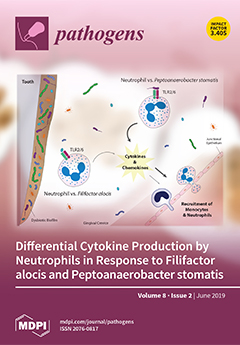Staphylococcus aureus is one of the most important pathogens of humans and animals. Livestock production contributes a significant proportion to the South African Gross Domestic Product. Consequently, the aim of this study was to determine for the first time the prevalence, virulence, antibiotic and heavy metal resistance in livestock-associated
S. aureus isolated from South African livestock production systems. Microbial phenotypic methods were used to detect the presence of antibiotic and heavy metal resistance. Furthermore, molecular DNA based methods were used to genetically determine virulence as well as antibiotic and heavy metal resistance determinants. Polymerase chain reaction (PCR) confirmed 217 out of 403 (53.8%) isolates to be
S. aureus. Kirby-Bauer disc diffusion method was conducted to evaluate antibiotic resistance and 90.8% of
S. aureus isolates were found to be resistant to at least three antibiotics, and therefore, classified as multidrug resistant. Of the antibiotics tested, 98% of the isolates demonstrated resistance towards penicillin G. High resistance was shown against different heavy metals, with 90% (196/217), 88% (192/217), 86% (188/217) and 84% (183/217) of the isolates resistant to 1500 µg/mL concentration of Cadmium (Cd), Zinc (Zn), Lead (Pb) and Copper (Cu) respectively. A total of 10 antimicrobial resistance and virulence genetic determinants were screened for all livestock associated
S. aureus isolates. Methicillin-resistant
S. aureus (MRSA) isolates were identified, by the presence of
mecC, in 27% of the isolates with a significant relationship (
p < 0.001)) with the host animal. This is the first report of
mecC positive LA-MRSA in South Africa and the African continent. The gene for tetracycline resistance (
tetK) was the most frequently detected of the screened genes with an overall prevalence of 35% and the highest prevalence percentage was observed for goats (56.76%) followed by avian species (chicken, duck and wild birds) (42.5%). Virulence-associated genes were observed across all animal host species. The study reports the presence of
luks/pv, a gene encoding the PVL toxin previously described to be a marker for community acquired-MRSA, suggesting the crossing of species between human and livestock. The high prevalence of
S. aureus from the livestock indicates a major food security and healthcare threat. This threat is further compounded by the virulence of the pathogen, which causes numerous clinical manifestations. The phenomenon of co-selection is observed in this study as isolates exhibited resistance to both antibiotics and heavy metals. Further, all the screened antibiotic and heavy metal resistance genes did not correspond with the phenotypic resistance.
Full article






